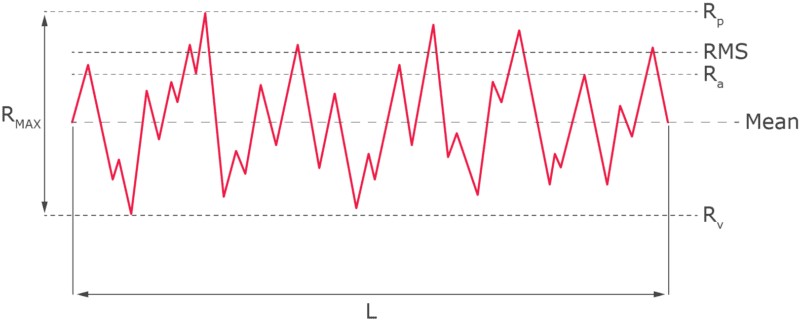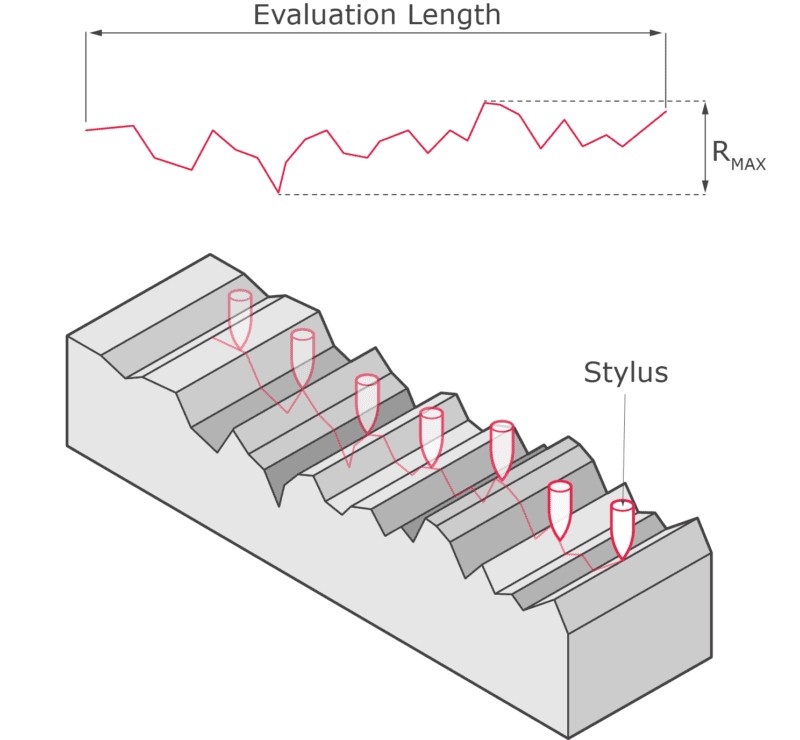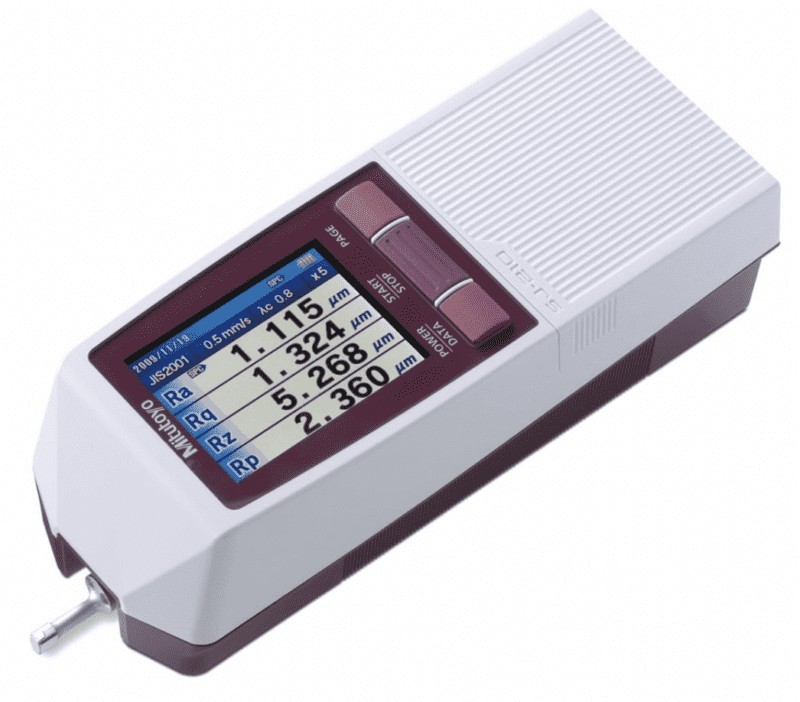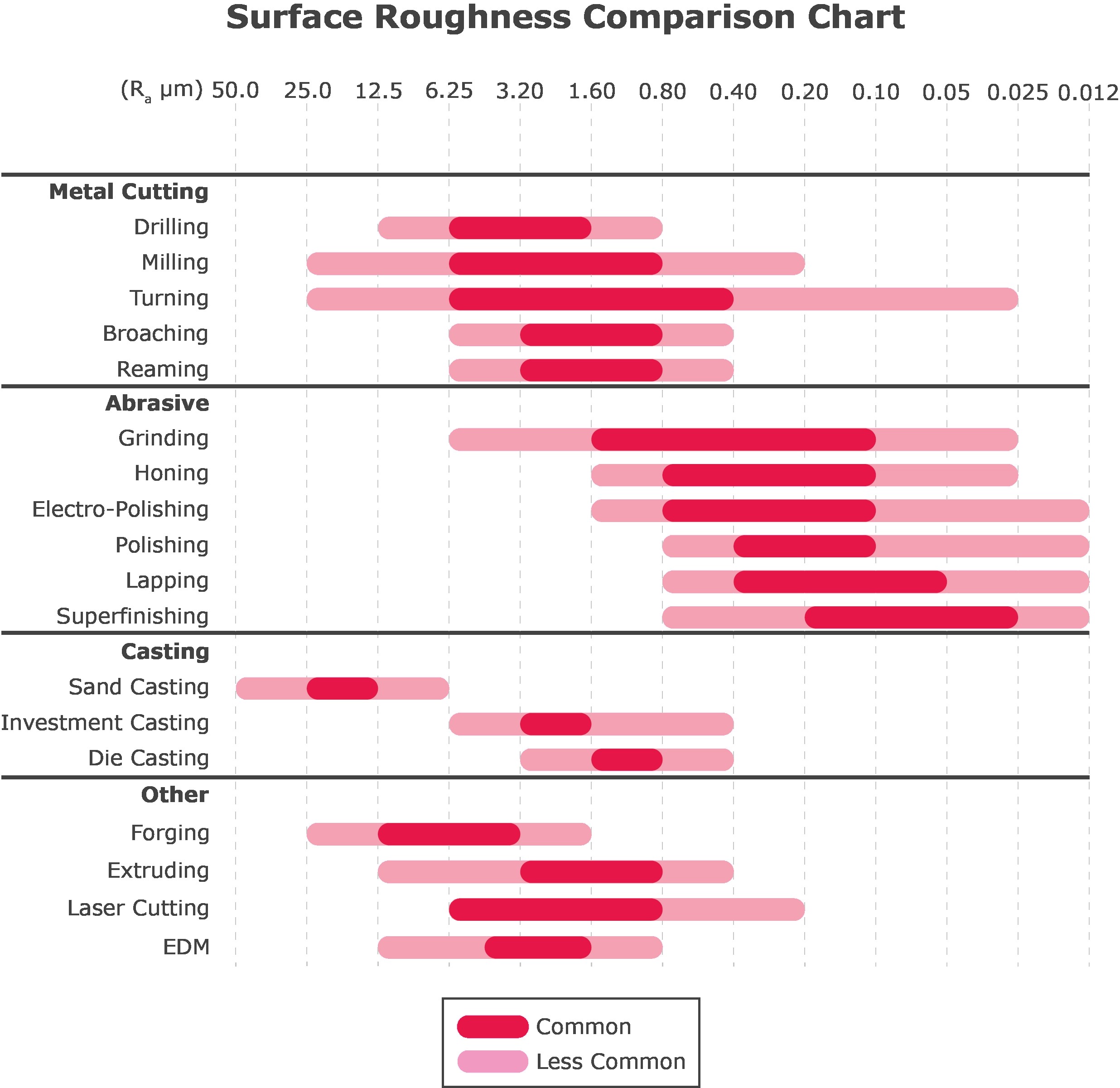A Visual Comparator Chart For The Surface Finish From Machining is an essential tool for engineers and manufacturers to assess and control the quality of machined parts. COMPARE.EDU.VN offers a comprehensive guide to understanding, measuring, and comparing surface roughness to achieve optimal results. This article will explore the various aspects of surface finish, measurement methods, and how to use a visual comparator chart effectively and surface texture analysis.
1. Understanding Surface Roughness in Machining
Surface roughness refers to the microscopic texture of a machined surface, defined by deviations from its nominal shape. The magnitude of these deviations determines the surface’s smoothness; smaller deviations indicate a smoother surface, while larger deviations indicate a rougher surface. Surface roughness impacts the functional performance, aesthetics, and overall quality of machined parts.
1.1. Importance of Surface Finish
The surface finish is a critical factor in determining how a manufactured part interacts with its environment. A smoother surface can reduce friction and wear in sliding parts, while a rougher surface can enhance adhesion for coatings or provide a better grip. Understanding the desired surface roughness is essential for optimizing part performance and longevity.
1.2. Surface Roughness Parameters
Several parameters are used to quantify surface roughness, including:
- Ra (Average Roughness): The arithmetic average of the absolute values of the surface height deviations measured from the mean line.
- Rz (Maximum Height): The average of the absolute distances between the highest peaks and lowest valleys within a specified evaluation length.
- Rp (Maximum Peak Height): The distance between the highest peak and the mean line within the evaluation length.
- Rv (Maximum Valley Depth): The distance between the lowest valley and the mean line within the evaluation length.
- Rmax (Maximum Roughness): The largest peak-to-valley distance within the evaluation length.
- RMS (Root Mean Square): The root mean square average of the profile height variation from the mean line.
These parameters provide different perspectives on surface texture and are used in various applications to specify surface finish requirements.
1.3. Units of Measurement
Surface roughness is typically measured in micrometers (µm) or micro-inches (µ-in). One micrometer equals approximately 40 micro-inches. The choice of unit depends on industry standards and the specific application.
2. Visual Comparator Charts: An Overview
A visual comparator chart is a reference tool used to assess the surface roughness of a manufactured part by visually comparing it against known standards. These charts typically consist of a series of sample surfaces with different roughness values, allowing engineers and technicians to quickly estimate the surface finish of a part.
2.1. How Visual Comparator Charts Work
The process involves visually inspecting the machined surface and comparing it to the sample surfaces on the chart. By matching the texture of the part to the closest standard, the surface roughness can be estimated. Visual comparators are useful for quick checks and quality control in manufacturing environments.
2.2. Types of Visual Comparator Charts
Visual comparator charts are available for various machining processes, including:
- CNC Machining: Charts for assessing surface roughness produced by CNC milling, turning, and grinding.
- Extrusion: Charts for evaluating the surface finish of extruded materials.
- Molding: Charts for comparing the surface texture of molded parts.
- Casting: Charts for assessing the surface roughness of cast components.
- 3D Printing: Charts for evaluating the surface finish of 3D-printed parts.
Each chart is tailored to the specific characteristics of the respective manufacturing process.
2.3. Advantages and Limitations
Visual comparator charts offer several advantages:
- Cost-Effective: They are relatively inexpensive compared to more sophisticated measurement tools.
- Easy to Use: They require minimal training and can be used by anyone.
- Quick Assessment: They provide a fast way to estimate surface roughness.
However, they also have limitations:
- Subjective: The assessment relies on visual comparison, which can be subjective and prone to error.
- Limited Accuracy: They offer a rough estimate and are not suitable for applications requiring high precision.
- Dependence on Lighting: Accurate comparison depends on proper lighting conditions.
Despite these limitations, visual comparator charts remain a valuable tool for many applications where a quick, approximate assessment of surface roughness is sufficient.
3. Standard Surface Finishes in Machining
The standard surface finish for a machined part varies depending on the application and the manufacturing process. Generally, a surface finish of 3.2 μm Ra is considered standard for many machined parts.
3.1. Achievable Surface Roughness
Achievable surface roughness averages through CNC machining include:
- 3.2 μm Ra: A typical finish for parts that require moderate precision.
- 1.6 μm Ra: A smoother finish with fewer visible tool marks.
- 0.8 μm Ra: A fine finish suitable for parts exposed to concentrated stress.
- 0.4 μm Ra: A high-grade finish with no visible tool marks, ideal for critical applications.
3.2. Factors Influencing Surface Finish
Several factors influence the surface finish in machining:
- Machining Process: Different processes, such as milling, turning, grinding, and polishing, produce varying surface finishes.
- Cutting Tool: The geometry, material, and condition of the cutting tool affect the surface roughness.
- Cutting Parameters: Cutting speed, feed rate, and depth of cut influence the surface finish.
- Material: Different materials exhibit varying machining characteristics and surface finish outcomes.
- Coolant: The type and application of coolant affect the surface roughness by reducing friction and heat.
3.3. Types of Machining Finishes
Machining finishes refer to the final surface texture and appearance of a part after machining. Common types include:
- As-Machined Finish: The surface finish results directly from the machining process without any post-processing. It may have visible tool marks and is not typically very smooth.
- Smooth Finish: Achieved through grinding or honing, this finish has a very fine surface texture. It’s ideal for parts that require a smooth surface for functional or aesthetic reasons.
- Textured Finish: Some parts may require a textured surface for grip, aesthetics, or other functional reasons. This can be achieved through knurling or bead blasting.
- Mirror Finish: This is a highly polished finish that reflects light, similar to a mirror. It’s achieved through extensive polishing and is often used for decorative parts.
- Anodized Finish: For metals like aluminum, an anodizing process can be used to create a protective oxide layer on the surface. This not only provides protection but can also add color to the part.
3.4. Selecting the Right Surface Finish
Choosing the suitable surface finish is crucial for ensuring the part meets the required functional and aesthetic requirements. Consider the following factors:
- Application: The intended use of the part dictates the required surface roughness.
- Durability: The surface finish affects the wear resistance and longevity of the part.
- Aesthetics: The visual appearance of the part is important in some applications.
- Budget: Finer surface finishes require more processing and can increase manufacturing costs.
4. Measurement Techniques for Surface Roughness
Several methods are available for measuring surface roughness, each with its advantages and limitations.
4.1. Contact Profilometer
A contact profilometer measures surface roughness by moving a diamond stylus across the surface of the part. The displacement of the stylus is converted into digital values, providing a detailed profile of the surface texture.
4.1.1. Advantages
- High Accuracy: Provides precise measurements of surface roughness parameters.
- Versatility: Suitable for various materials and surface types.
4.1.2. Limitations
- Potential Damage: The stylus can potentially cause damage to the surface.
- Slow: Measurement process can be time-consuming.
4.2. Non-Contact Profilometer
A non-contact profilometer uses light rather than a physical probe to measure surface roughness. Techniques include laser triangulation, confocal microscopy, and digital holography.
4.2.1. Advantages
- No Damage: Eliminates the risk of damaging the surface.
- Fast: Offers a faster measurement process compared to contact methods.
- Large Area Measurement: Capable of measuring larger surface areas.
4.2.2. Limitations
- Cost: Non-contact profilometers can be more expensive than contact profilometers.
- Material Limitations: Some materials may not be suitable for non-contact measurement due to their optical properties.
4.3. Portable Surface Roughness Tester
A portable surface roughness tester is a compact, battery-powered device that uses a stylus to measure surface roughness. It displays sectional calculation results, amplitude distribution curves, and original surface roughness calculations on a backlit screen.
4.3.1. Advantages
- Portability: Allows for on-site measurements without the need for a power outlet.
- Ease of Use: Simple to operate and provides immediate results.
4.3.2. Limitations
- Accuracy: May not be as accurate as more sophisticated measurement tools.
- Potential Damage: Similar to contact profilometers, the stylus can potentially damage the surface.
4.4. Surface Roughness Comparator
A surface roughness comparator is a manual tool used to visually assess surface roughness by comparing the manufactured part against industry-standard finish grades.
4.4.1. Advantages
- Cost-Effective: Inexpensive compared to digital measurement tools.
- Easy to Use: Requires minimal training and can be used by anyone.
4.4.2. Limitations
- Subjectivity: Relies on visual comparison, which can be subjective and prone to error.
- Limited Accuracy: Provides a rough estimate and is not suitable for applications requiring high precision.
5. Manufacturing Surface Roughness Comparison Chart
A surface roughness comparison chart is an essential guideline for engineers, enabling them to compare common surface roughness values for different manufacturing processes. Understanding such a chart and the conversion between contrasting units of measurement is a useful addition to any engineer’s arsenal.
5.1. Interpreting the Chart
The chart typically displays a range of Ra values corresponding to different manufacturing processes. By visually comparing the surface of a part to the chart, engineers can estimate the surface roughness and determine if it meets the required specifications.
5.2. Common Manufacturing Processes and Surface Roughness Values
Here are some common manufacturing processes and their typical surface roughness values:
| Manufacturing Process | Typical Ra Value (µm) |
|---|---|
| Grinding | 0.05 – 1.6 |
| Honing | 0.1 – 0.8 |
| Lapping | 0.025 – 0.4 |
| Polishing | 0.012 – 0.2 |
| Milling | 0.4 – 6.3 |
| Turning | 0.8 – 6.3 |
| Electrical Discharge Machining (EDM) | 0.2 – 12.5 |
| 3D Printing (Additive Manufacturing) | 5 – 50 |
| Investment Casting | 1.6 – 6.3 |
| Sand Casting | 6.3 – 25 |




5.3. Surface Roughness Conversion Table
A surface roughness conversion table provides a means of converting between different units of measurement, such as micrometers (µm), micro-inches (µ-in), and ISO roughness grade numbers (N).
| Ra (Micro-meters) | Ra (Micro-inches) | Rt** | N |
|---|---|---|---|
| 0.025 | 1 | 0.3 | N1 |
| 0.05 | 2 | 0.5 | N2 |
| 0.1 | 4 | 0.8 | N3 |
| 0.2 | 8 | 1.2 | N4 |
| 0.4 | 16 | 2 | N5 |
| 0.8 | 32 | 4 | N6 |
| 1.6 | 63 | 8 | N7 |
| 3.2 | 125 | 13 | N8 |
| 6.3 | 250 | 25 | N9 |
| 12.5 | 500 | 50 | N10 |
| 25 | 1000 | 100 | N11 |
| 50 | 2000 | 200 | N12 |
Understanding these conversions is essential for ensuring consistency and accuracy in surface roughness measurements.
6. Cost Considerations for Surface Roughness
The cost of achieving a specific surface roughness is an important consideration in manufacturing. Finer surface finishes require more processing and can increase manufacturing costs.
6.1. Factors Affecting Cost
Several factors impact the cost of surface roughness finishes:
- Machining Time: Achieving finer surface finishes requires longer machining times.
- Tooling Costs: Specialized cutting tools and abrasives may be necessary for achieving specific surface finishes.
- Post-Processing: Additional processes, such as grinding, polishing, or lapping, can add to the cost.
- Material Costs: Some materials are more difficult to machine and may require more expensive processes to achieve the desired surface finish.
6.2. Balancing Cost and Quality
Engineers must balance the cost of achieving a specific surface roughness with the functional and aesthetic requirements of the part. In some cases, a less expensive, rougher surface finish may be acceptable, while in others, a more expensive, finer surface finish is necessary.
6.3. Optimizing Manufacturing Processes
Optimizing manufacturing processes can help reduce the cost of achieving specific surface finishes. This may involve selecting the appropriate machining parameters, using advanced cutting tools, and implementing efficient post-processing techniques.
7. Surface Roughness Symbols and Abbreviations
Understanding surface roughness symbols and abbreviations is crucial for interpreting engineering drawings and specifications.
7.1. Common Symbols
Here are some common surface roughness symbols and their meanings:
- = : The marks made by a cutting tool during machining when parallel with the surface or view on the drawing.
- ⊥ : The marks made by the cutting tool during machining that are perpendicular to the surface or view on the drawing.
- X : The marks made by the cutting tool during machining when at an angle and cross each other, in a criss-cross pattern.
- M : The marks made commonly by polishing or lapping that cross multiple times or have no set direction.
- C : The marks made by the cutting tool when forming mostly concentric circles in relation to the centre of the surface.
- R : The marks made by a cutting tool during machining when parallel with the surface.
7.2. Abbreviations
Common abbreviations used in surface roughness specifications include:
- Ra: Average Roughness
- Rz: Maximum Height
- Rp: Maximum Peak Height
- Rv: Maximum Valley Depth
- Rmax: Maximum Roughness
- RMS: Root Mean Square
8. Practical Applications of Surface Roughness Control
Surface roughness control is essential in various industries and applications.
8.1. Automotive Industry
In the automotive industry, surface finish is critical for components such as engine parts, gears, and bearings. Controlling surface roughness reduces friction, improves wear resistance, and enhances overall performance.
8.2. Aerospace Industry
In the aerospace industry, surface finish is crucial for components such as turbine blades, airfoils, and landing gear. Controlling surface roughness improves aerodynamic performance, reduces drag, and enhances structural integrity.
8.3. Medical Device Industry
In the medical device industry, surface finish is critical for implants, surgical instruments, and diagnostic equipment. Controlling surface roughness improves biocompatibility, reduces the risk of infection, and enhances overall functionality.
8.4. Electronics Industry
In the electronics industry, surface finish is critical for components such as connectors, printed circuit boards, and semiconductor devices. Controlling surface roughness improves electrical conductivity, reduces signal loss, and enhances overall reliability.
9. Surface Finish Measurements
Surface finish measurements are essential metrics used to quantify the texture and topography of a manufactured surface. These measurements provide insights into the quality, functionality, and aesthetic appeal of a product. The process involves assessing the deviations and irregularities on a surface, which can be caused by various manufacturing processes such as machining, grinding, casting, and more.
To perform surface finish measurements:
- Select the Appropriate Instrument: Depending on the type of surface and the level of precision required, choose a suitable instrument. Common tools include profilometers, interferometers, and atomic force microscopes.
- Prepare the Surface: Ensure the surface is clean and free from contaminants. Any debris or dirt can affect the accuracy of the measurements.
- Calibrate the Instrument: Before taking measurements, calibrate the instrument according to the manufacturer’s guidelines.
- Measure the Surface: Glide the instrument’s probe or sensor across the surface to capture a profile. This profile represents the peaks and valleys of the surface texture.
- Analyze the Data: Using specialized software, analyze the captured data to determine key parameters such as Ra (average roughness), Rz (maximum height), and more.
By understanding and controlling surface finish measurements, manufacturers can ensure that their products meet desired specifications and performance criteria.
10. Surface Texture Analysis
Surface texture analysis is a comprehensive evaluation of a surface’s micro-geometry, encompassing roughness, waviness, and form. It involves advanced techniques to quantify and characterize surface irregularities, providing valuable insights into a surface’s functional performance, aesthetic qualities, and manufacturing process control.
10.1 Importance of Surface Texture Analysis
Surface texture analysis is crucial for optimizing surface properties to meet specific application requirements. By understanding surface texture, engineers can:
- Enhance Friction and Wear Properties: Controlling surface texture can reduce friction and wear, improving the lifespan and efficiency of mechanical components.
- Improve Adhesion and Coating Performance: Surface texture affects the adhesion of coatings and adhesives, ensuring reliable bonding and protection.
- Control Fluid Flow and Sealing: Precise surface textures can optimize fluid flow in microfluidic devices and improve sealing performance in hydraulic systems.
- Enhance Aesthetic Appeal: Surface texture can be tailored to achieve desired visual effects and tactile feel, enhancing the aesthetic appeal of consumer products.
10.2 Techniques for Surface Texture Analysis
Several advanced techniques are used for surface texture analysis, including:
- Confocal Microscopy: Captures high-resolution 3D images of surface topography, providing detailed information about roughness, waviness, and form.
- Interferometry: Uses interference patterns of light to measure surface height variations with nanometer-scale resolution, enabling precise characterization of surface texture.
- Atomic Force Microscopy (AFM): Scans a sharp probe across a surface to map its topography at the atomic level, providing ultra-high-resolution measurements of surface roughness and features.
- 3D Optical Profilometry: Projects structured light patterns onto a surface and analyzes the resulting distortions to reconstruct a 3D model of the surface texture, enabling rapid and non-destructive measurements.
10.3 Applications of Surface Texture Analysis
Surface texture analysis is applied in various industries to optimize surface properties and improve product performance:
- Automotive: Analyzing surface texture of engine components to reduce friction and wear, improving fuel efficiency and engine lifespan.
- Aerospace: Evaluating surface texture of turbine blades to enhance aerodynamic performance and improve fuel efficiency.
- Medical Devices: Characterizing surface texture of implants to improve biocompatibility and reduce the risk of infection.
- Electronics: Analyzing surface texture of printed circuit boards to improve solderability and enhance electrical conductivity.
By employing surface texture analysis, manufacturers can gain valuable insights into surface properties, optimize manufacturing processes, and ensure that products meet desired specifications and performance criteria.
11. FAQ Section
Q1: What is surface roughness?
Surface roughness is a measure of the texture of a surface, quantified by the deviations from its nominal shape.
Q2: Why is surface roughness important in machining?
Surface roughness affects the functional performance, aesthetics, and overall quality of machined parts.
Q3: What are the common parameters used to measure surface roughness?
Common parameters include Ra, Rz, Rp, Rv, Rmax, and RMS.
Q4: What is a visual comparator chart?
A visual comparator chart is a reference tool used to assess surface roughness by visually comparing a part against known standards.
Q5: What are the advantages and limitations of using a visual comparator chart?
Advantages include cost-effectiveness and ease of use, while limitations include subjectivity and limited accuracy.
Q6: How is surface roughness measured?
Surface roughness can be measured using contact profilometers, non-contact profilometers, portable surface roughness testers, and visual comparator charts.
Q7: What is the standard surface finish for a machined part?
The standard surface finish for a machined part is typically 3.2 μm Ra.
Q8: How does surface roughness affect the cost of manufacturing?
Finer surface finishes require more processing and can increase manufacturing costs.
Q9: What are some common applications of surface roughness control?
Surface roughness control is essential in the automotive, aerospace, medical device, and electronics industries.
Q10: How can COMPARE.EDU.VN help in understanding surface roughness?
COMPARE.EDU.VN provides a comprehensive guide to understanding, measuring, and comparing surface roughness to achieve optimal results.
Conclusion
Understanding and controlling surface roughness is crucial for achieving optimal performance and quality in machined parts. A visual comparator chart for the surface finish from machining, in conjunction with other measurement techniques, provides a valuable tool for engineers and manufacturers. By considering the factors that influence surface finish, selecting the appropriate measurement method, and optimizing manufacturing processes, it is possible to achieve the desired surface roughness at a reasonable cost. For more detailed comparisons and resources, visit COMPARE.EDU.VN to make informed decisions. Our address is 333 Comparison Plaza, Choice City, CA 90210, United States. Contact us via Whatsapp at +1 (626) 555-9090 or visit compare.edu.vn for further assistance and detailed comparison charts.